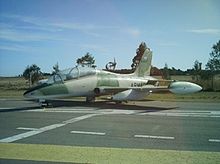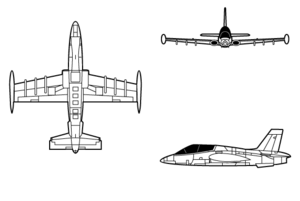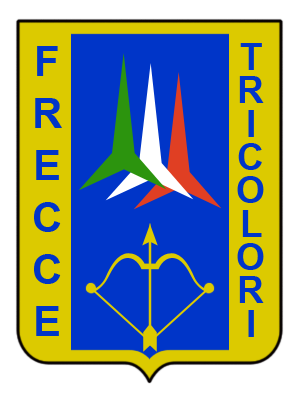Development
During September 1972, Aermacchi was awarded a contract to study a replacement for the Italian Air Force's aging MB-326 fleet, a type which had effectively been the standard advanced jet trainer of the 1960s. [2] During this study, designers at the company compared seven all-new designs (which were collectively referred to by the designation of MB-338) against an improved version of the MB-326, which was designated MB-339. [3] It was determined that the envisioned MB-339 would be capable to satisfying the established requirements of the Italian Air Force, while also being cheaper than producing any of the rival clean-sheet designs. Accordingly, Aermacchi submitted the MB-339 for official evaluation; during 1975, it was selected to replace both the MB-326 and the Fiat G.91T fleets that were then in Italian service. [3] [2]
On 12 August 1976, the maiden flight of the prototype, designated MB-339X, took place. [2] During July 1978, the first production-standard aircraft made its first flight; during the following year, deliveries of the MB-339A to the Italian Air Force commenced. [4] The service would be the primary operator of the type; reportedly, between 1978 and 1987, 101 MB-339As would be induced into the Italian Air Force, which is roughly just under half of the total examples of the type to have been constructed to date. [2]
Various improved models would be developed by Aermacchi. During 1980, a dedicated single-seat attack variant, referred to as the MB-339K Veltro II, performed its maiden flight. [2] During 1985, the MB-339B, which incorporated a light-attack capability, entered operational service. That same year, the first MB-339C, which featured various refinements and was intended as a dual-use aircraft, made its first flight. [2] During the late 1980s, the enhanced MB-339C was made available to customers; this model principally differed from preceding variants via the implementation of a much-modernised cockpit. Early on, the Italian government chose to procure the MB-339CD; [2] in addition to the fully digital cockpit, this variant was furnished with a fixed probe for aerial refueling, enabling its use for refueling training. [5] [6]
During 1989, Aermacchi formed a partnership with American defense conglomerate Lockheed and the aircraft division of General Motors to jointly bid in the American Joint Primary Aircraft Training System (JPATS) programme. [2] The Italian-American team proposed a modified model of the MB-339, referred to as the T-Bird II, to contend for the competition. If successful, Lockheed would have acted as the prime contractor and system integrator, assembling the T-Bird II at its Marietta facility, while General Motors was to provide its computerised training experience. [2] However, the bid was ultimately not successful; instead, a rival turboprop-powered submission by Raytheon and Pilatus was awarded the contract to produce the T-6 Texan II for this requirement. [7]
Throughout the 1990s and into the 2000s, multiple tranches of the MB-339CD variant would be inducted into Italian service. [8] Furthermore, various operators chose to have their existing aircraft remanufactured to the more advanced MB-339C standard. During the 2000s, the MB-339FD (FD standing for Full Digital), was proposed but ultimately attracted little market interest. [2] During 2006, it was announced that the MB-339 assembly line, which had been shuttered for several years, would be revived in response to interest in further orders of the type being expressed by three separate customers. [9] [10] [11]
During the 1990s and 2000s, as a result of corporate mergers and restructuring, the MB-339 became only one of several training aircraft being offered by Aermacchi, other aircraft being propeller-driven SF-260, the basic S.211, M-311, and the M-346. [12] [13] According to company Giorgio Brazzelli, its various training platforms come together to form part of an integrated training system to its customers. [14]
Design
The Aermacchi MB-339 is a military jet trainer and light attack aircraft, featuring a conventional configuration, tricycle undercarriage and all-metal construction. It has many similarities with the design of the MB-326, sharing the majority of its airframe with the older aircraft. [15] According to aviation periodical Air International, the most significant revision of the MB-339 was a redesigned forward fuselage, which raised the instructor's seat to allow visibility over and past the student pilot's head. In typical operations, the aircraft is flown by a crew of two, who are seated in a tandem configuration; during training missions, the student is seated in the forward position while the observing instructor is placed directly behind and somewhat above them. [15] The cockpit is pressurised and is covered by a jettisonable canopy which works in conjunction with the twin Martin-Baker-built ejection seats. [2]
The MB-339 possesses a low, un-swept wing complete with tip tanks; the air intakes for the single turbojet engine is located within the wing roots. [15] This wing is identical to that used on the older MB-326K model. [2] The powerplant used for the aircraft's initial versions was the Rolls-Royce Viper 632-43 turbojet engine, which was capable of producing a maximum thrust of 4,000 lbf (17.8 kN); this is the same model as installed upon the older MB-326K model. Later models, such as the MB-339C, are furnished with the more powerful Viper 680 engine, which can generate up to 4,300 lbf (19.57 kN) of thrust. [2] For improved aerodynamics, the MB-339 features an enlarged tailfin over its predecessor. [15]
While some models of the MB-339 are primarily intended for training operations, other are instead principally equipped to perform light fighter and fighter-bomber roles. Combat-orientated aircraft are typically outfitted with more advanced avionics, such as improved inertial guidance systems, digital nav/attack computers, a MIL-STD-1553B databus, and hands-on throttle-and-stick (HOTAS)-compatible flight controls. [2] Furthermore, various defensive systems, such as a radio jammer, radar warning receiver (RWR), electronic countermeasures (ECM), along with larger wingtip tanks, would typically be adopted. The MB-339K carries a pair of 30mm DEFA cannon while a total of six underwing hard points can accommodate up to 1,815 kilograms (4,000 lb) of external stores. [2] It has been qualified to be armed with various munitions, such as the Sidewinder and R.550 Magic air-to-air missiles, the AGM-65 Maverick air-to-surface missile, various laser-guided bombs and rockets, as well as the Marte Mk.2 anti-ship missile. According to Forecast International, Aermacchi had at one point considered making provisions for the installation of an additional two pod-mounted 30mm cannon. [2]
























